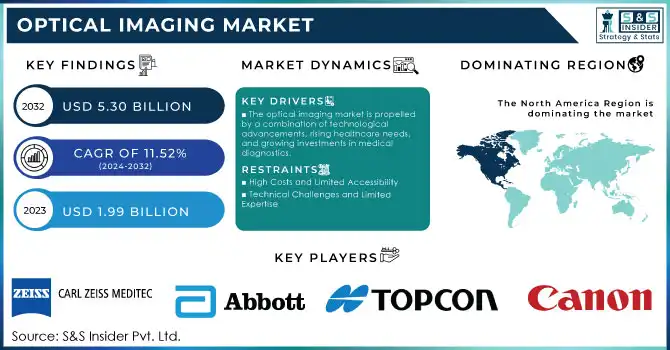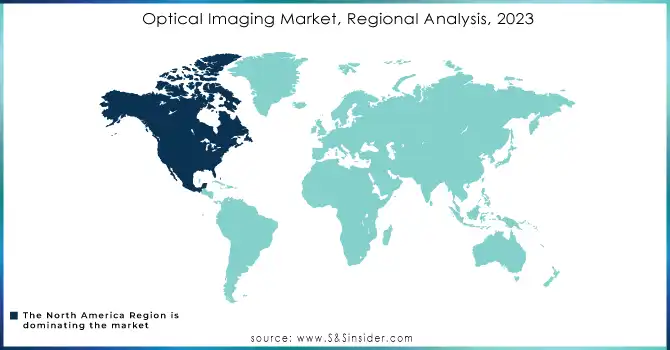Optical Imaging Market Size Analysis:
The Optical Imaging Market size was valued at USD 1.99 billion in 2023 and is expected to reach USD 5.30 billion by 2032, growing at a CAGR of 11.52% during the forecast period of 2024-2032.

Get More Information on Optical Imaging Market - Request Sample Report
The global optical imaging market is experiencing transformative growth. Factors influencing this are technological innovations and the increasing need for accurate, non-invasive diagnostic tools. According to a study by Nature Communications, advancements in adaptive optics have enabled unprecedented imaging clarity through scattering media, promising breakthroughs in deep tissue visualization. The prevalence of chronic diseases such as cancer and neurodegenerative disorders, which require high-resolution diagnostics, is a key driver of this trend. It is estimated that over 19.3 million new cancer cases were diagnosed globally in 2020, according to the International Agency for Research on Cancer (IARC), highlighting the critical need for advanced imaging solutions.
Optical imaging technologies like optical coherence tomography (OCT) and near-infrared fluorescence (NIRF) imaging are witnessing rapid adoption due to their ability to provide real-time, high-resolution images at the cellular level. For instance, a study in the Survey of Ophthalmology highlighted the application of OCT in ophthalmology, improving early detection of retinal diseases, which affect over 146 million people worldwide. Similarly, NIRF imaging has shown significant promise in oncology for tumor margin detection during surgeries.
Recent advancements have further accelerated the market. A groundbreaking development published by researchers at the Hebrew University demonstrated a novel non-invasive imaging technique capable of imaging through scattering media, marking a substantial leap forward in diagnostics. Meanwhile, portable and compact imaging devices are emerging, improving accessibility in remote and underserved areas.
AI integration is another transformative factor. Studies such as one in Nature Biotechnology revealed that AI algorithms improve diagnostic accuracy by up to 30%, particularly in applications like automated OCT image analysis. These innovations, coupled with increasing healthcare investments and government initiatives to promote early diagnosis, are bolstering the market's trajectory.
The combination of advanced research, robust adoption across clinical applications, and rising global healthcare needs positions the optical imaging market as a cornerstone of modern diagnostics, with a transformative impact expected in the coming years.
Global Optical Imaging Market Dynamics
Drivers
-
The optical imaging market is propelled by a combination of technological advancements, rising healthcare needs, and growing investments in medical diagnostics.
A key driver is the increasing prevalence of chronic diseases such as cancer, cardiovascular disorders, and neurological conditions, which demand advanced diagnostic solutions for early detection and treatment planning. According to the World Health Organization (WHO), chronic diseases account for nearly 71% of global deaths annually, emphasizing the critical role of high-resolution imaging technologies in reducing this burden.
Technological breakthroughs are at the forefront of market growth. Innovations such as optical coherence tomography (OCT), adaptive optics, and near-infrared fluorescence (NIRF) imaging are expanding diagnostic capabilities across ophthalmology, oncology, and cardiology. For example, OCT is widely adopted in eye care, with studies showing its efficacy in detecting retinal disorders, while NIRF imaging is transforming surgical oncology by enabling real-time tumor visualization.
The integration of artificial intelligence (AI) into imaging systems is another significant driver, enhancing image interpretation and diagnostic accuracy. According to a study in Nature Biotechnology, AI algorithms have improved diagnostic precision by up to 30%, particularly in complex imaging scenarios.
Additionally, increasing investments in healthcare infrastructure and research, with initiatives to improve access to diagnostics in underserved regions, are fostering market expansion. Portable imaging devices and non-invasive imaging technologies are making advanced solutions accessible globally, driving their adoption in clinical and research settings. These factors collectively position optical imaging as a vital component of modern healthcare.
Restraints
-
High Costs and Limited Accessibility
The advanced technologies used in optical imaging systems, such as optical coherence tomography (OCT) and near-infrared fluorescence (NIRF) imaging, often involve substantial development and maintenance costs. This makes these solutions expensive for many healthcare providers, particularly in low-income and rural areas, limiting widespread adoption.
-
Technical Challenges and Limited Expertise
Optical imaging technologies require specialized knowledge for operation and interpretation. A shortage of trained professionals and the complexity of integrating these systems into existing healthcare workflows pose significant barriers to their adoption, especially in emerging markets.
Optical Imaging Market Segmentation Analysis
By Product
Imaging systems accounted for the largest share in 2023, dominating with approximately 45.0% of the market. This dominance is attributed to their extensive application across various fields, such as ophthalmology, neurology, and oncology. High demand for advanced imaging solutions like optical coherence tomography (OCT) and near-infrared fluorescence (NIRF) imaging systems drives this segment. Their capability to provide high-resolution, real-time imaging for early diagnosis and treatment planning has made them indispensable in both clinical and research settings.
The software segment is expected to witness the fastest growth, driven by the integration of artificial intelligence (AI) and machine learning (ML) technologies into imaging solutions. AI-enhanced software significantly improves diagnostic accuracy and automates image interpretation, making it a key enabler for precision medicine. This segment is anticipated to grow at a CAGR of over 12% during the forecast period.
By Application
Ophthalmology led the market in 2023, holding a 35.0% share. The widespread adoption of optical coherence tomography (OCT) for the early detection of retinal disorders, glaucoma, and age-related macular degeneration contributed significantly to this dominance. The aging population and rising prevalence of eye disorders further bolster the demand in this segment.
Oncology is projected to be the fastest-growing segment due to the rising incidence of cancer and the increasing need for precise imaging technologies for tumor detection and treatment planning. Near-infrared fluorescence (NIRF) imaging, used in real-time tumor visualization and margin assessment during surgeries, is driving this growth, with the segment expected to grow at a CAGR exceeding 14% in the coming years.
Regional Insights
North America dominated the market, accounting for the largest share in 2023, driven by advanced healthcare infrastructure, increased healthcare spending, and strong research activities. The U.S. is home to major players such as Abbott, PerkinElmer, and Hamamatsu Photonics, who contribute significantly to the market through the development of cutting-edge imaging technologies. The growing prevalence of chronic diseases, along with a focus on early diagnostics, particularly in ophthalmology and oncology, fuels the demand for optical imaging solutions in this region.
Europe followed closely behind, with countries like Germany, the U.K., and France leading the market. The presence of prominent companies like Carl Zeiss Meditec and Heidelberg Engineering further strengthens Europe’s position. The region benefits from strong investments in healthcare research, particularly in the fields of dermatology, ophthalmology, and oncology. Additionally, European Union funding programs for medical technologies support market growth.
Asia-Pacific is the fastest-growing region, driven by increasing healthcare investments, rising disposable incomes, and the growing demand for advanced diagnostic tools. Countries such as Japan, China, and India are witnessing rapid adoption of optical imaging technologies, especially in ophthalmology and oncology. The rise of local manufacturers, like MOPTIM and Cylite, is contributing to regional market expansion. The region is expected to grow at a significant pace, with a focus on improving healthcare access in emerging markets.

Need Any Customization Research On Optical-Imaging-Market - Inquiry Now
Optical Imaging Market Key Players
-
Carl Zeiss Meditec: Optical coherence tomography systems, fundus cameras, slit lamps, surgical microscopes
-
Abbott: Advanced imaging systems
-
Topcon Corporation: OCT systems, fundus cameras, ophthalmic imaging software, slit lamps
-
Canon: OCT systems, fundus cameras
-
PerkinElmer: Imaging systems, microscopy solutions
-
Koninklijke Philips: Diagnostic imaging systems
-
Heidelberg Engineering: OCT systems, confocal scanning laser ophthalmoscopes
-
Leica Microsystems: Microscopes, imaging systems
-
Headwall Photonics: Hyperspectral imaging systems
-
Visionix: Ophthalmic diagnostic imaging systems
-
Optical Imaging: Non-invasive imaging solutions
-
Optos: Ultra-widefield retinal imaging devices
-
Wasatch Photonics: Spectroscopy and imaging systems
-
ArcScan: High-resolution OCT systems
-
DermaLumics: Optical coherence tomography devices
-
Cylite: 3D optical coherence tomography systems
-
MOPTIM: OCT systems
-
Michelson Diagnostics: Multibeam optical coherence tomography devices
-
Thorlabs: OCT systems, imaging components
-
Hamamatsu Photonics: Photodetectors, imaging modules
-
iTheraMedical: Optoacoustic imaging systems
-
Kibero: Multimodal imaging systems
-
Seno Medical: Optoacoustic breast imaging systems
-
Aspectus Imaging: Spectral imaging systems
-
Agfa-Gevaert: Digital imaging solutions
Recent Developments in the Optical Imaging Market
In September 2024, ZEISS unveiled its innovative ZEISS KINEVO 900 S Robotic Visualization System, offering enhanced digital visualization and seamless robotic integration, marking a significant advancement in the neurosurgery market. This cutting-edge system is set to revolutionize surgical precision and patient outcomes.
In Jan 2024, Leica Microsystems introduced an enhanced version of its ARveo 8 digital visualization microscope, featuring advanced 3D AR fluorescence for improved brain tumor and vascular surgery. The new GLOW400 and GLOW800 AR fluorescence systems provide clearer visualization of anatomical structures and vascular flow, while the MyVeo all-in-one surgical headset offers greater mobility, comfort, and efficiency in the operating room.
In Nov 2023, Cleveland Clinic partnered with Canon Inc. to establish a comprehensive imaging research center in the Cleveland Innovation District. This collaboration aims to drive global advancements in medical imaging solutions, fostering innovation and technological progress in the field.
In Oct 2023, Abbott launched its groundbreaking Ultreon 1.0 Software in India, integrating optical coherence tomography (OCT) with Artificial Intelligence (AI) to enhance coronary imaging. The software offers a streamlined, user-friendly interface, providing step-by-step guidance for physicians and improving insights to optimize patient outcomes.
| Report Attributes | Details |
|---|---|
| Market Size in 2023 | US$ 1.99 Billion |
| Market Size by 2032 | US$ 5.30 Billion |
| CAGR | CAGR of 11.52% From 2024 to 2032 |
| Base Year | 2023 |
| Forecast Period | 2024-2032 |
| Historical Data | 2020-2022 |
| Report Scope & Coverage | Market Size, Segments Analysis, Competitive Landscape, Regional Analysis, DROC & SWOT Analysis, Forecast Outlook |
| Key Segments | • By Product [Imaging Systems (Optical Imaging Systems, Spectral Imaging Systems), Illumination Systems, Lenses, Software] • By Application (Ophthalmology, Dentistry, Dermatology, Cardiology, Neurology, Oncology, Biotechnology and Research, Other Applications) • By Technique (Optical Coherence Tomography, Near Infrared Spectroscopy, Hyperspectral Imaging, Photoacoustic Tomography) • By End User (Diagnostic Imaging Center, Hospitals and Clinics, Research Laboratories, Other End Users) |
| Regional Analysis/Coverage | North America (US, Canada, Mexico), Europe (Eastern Europe [Poland, Romania, Hungary, Turkey, Rest of Eastern Europe] Western Europe [Germany, France, UK, Italy, Spain, Netherlands, Switzerland, Austria, Rest of Western Europe]), Asia Pacific (China, India, Japan, South Korea, Vietnam, Singapore, Australia, Rest of Asia Pacific), Middle East & Africa (Middle East [UAE, Egypt, Saudi Arabia, Qatar, Rest of Middle East], Africa [Nigeria, South Africa, Rest of Africa], Latin America (Brazil, Argentina, Colombia, Rest of Latin America) |
| Company Profiles | Carl Zeiss Meditec, Abbott, Topcon Corporation, Canon, PerkinElmer, Koninklijke Philips, Heidelberg Engineering, Leica Microsystems, Headwall Photonics, Visionix, Optical Imaging, Optos, Wasatch Photonics, ArcScan, DermaLumics, Cylite, MOPTIM, Michelson Diagnostics, Thorlabs, Hamamatsu Photonics, iTheraMedical, Kibero, Seno Medical, Aspectus Imaging, Agfa-Gevaert. |
| Key Drivers | • The optical imaging market is propelled by a combination of technological advancements, rising healthcare needs, and growing investments in medical diagnostics. |
| Restraints | • High Costs and Limited Accessibility • Technical Challenges and Limited Expertise |

